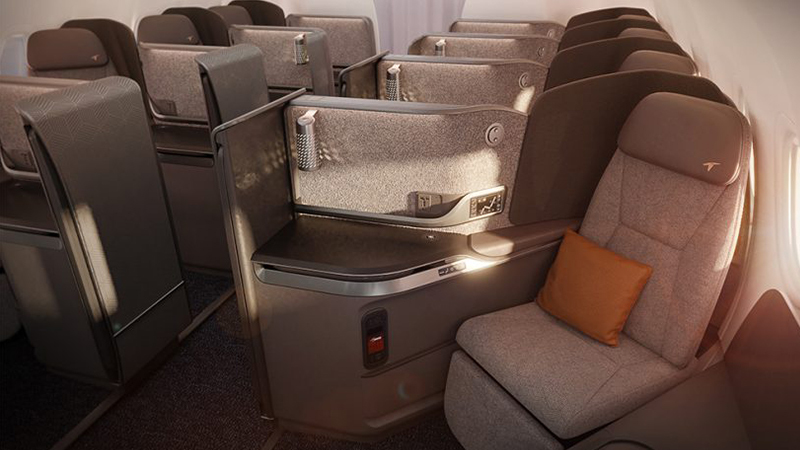

Image Courtesy: Thompson Aero Seating
Understandably, 2020 was a quiet year for the commercial aerospace industry. Aircraft interior companies used this downtime to work on novel systems for revolutionising the use of space in commercial airliners.
We spoke previously about the industry shift towards narrow- and wide-body aircraft and the move away from superjets. Aim Altitude and Thompson Aero Seating appear to be on board with this shift, judging by their new interior designs.
So, what are these new concepts and how will they impact the future of commercial air travel?
Aim Altitude is a major player in the aircraft interior scene. In 2020, it unveiled its ARCA system, originally designed as a space-saving meal tray system. The company identified a system’s issue relating to packaging: the crew loads trays into the aircraft without the meals. This leads to an inefficient use of space in aircraft where space is at a premium.
ARCA consists of stackable meal trays with a smaller footprint than current tray designs. The food is already in the tray, meaning its need much less space within the cabin. Once used, the trays stack together for easy storage and disposal. Also, it increases recycling possibilities and makes it easier to customise meals based on dietary requirements.
When the pandemic hit, Aim Altitude realised the benefit its tray would offer in terms of hygiene, too. Meals come sealed in a pack and the trays get resealed after use. This means greater confidence for both passengers and crew, drastically reducing the risk of cross-contamination.
As Aim claims, aircraft cabins have not changed much since the 1960s. Their function has remained the same despite changes to flight habits and cabin sizes. This has led to an inefficient use of time and space, which Aim has sought to address.
Its new design saves enough space to fit an extra row of seats in planes of around 300 economy seats. This will provide significant gain for flight carriers, as many struggles to deal with social distancing and efficient cabin use. Aim’s design was so revolutionary that it was a finalist in the Crystal Cabin Awards 2020/21. Aim’s design is due to launch at the 2021 Aircraft Interiors Expo.
Thompson Aero designed the new Vantage SOLO as an answer to space and access concerns in narrow-body aircraft. It is a single-aisle seat that converts into a fully horizontal bed from a 33” seat pitch. Importantly, each seat has direct access to the aisle, which will help to control hygiene in planes.
The seating unit will launch on a JetBlue Airbus A321 in summer 2021. JetBlue ordered a bespoke business class version of the unit that comes with suite doors, a first on a business-class A321. The baseline architecture of the SOLO can be adapted to open aisle, privacy screen, or suite door. This will allow passengers to retain the experience of a wide-body aircraft in smaller planes.
Much like the ARCA galley, Thompson’s design was not necessarily in response to the pandemic but will help airlines manage space in the future. It will be some time before passengers feel confident about returning to previous setups, so single-aisle seating will likely increase in popularity in the coming years.
SOLO seating units will sit in a reverse herringbone setup, positioning passengers away from the aisle. When converted into a bed, the passenger’s head is near the window, further reducing accidental contact with passers-by. This will minimise unnecessary contact but will also provide passengers with a superior sleeping experience.
Like almost every other industry, aerospace must find novel ways to adapt to the changing face of commercial air travel. The ARCA and SOLO units demonstrate there are ways to provide comfort and safety without compromising on accessibility and service.
Hopefully, this will renew passenger confidence in air travel, which has suffered greatly over the last 12 months. How the industry continues to adapt to these changes remains to be seen, but it is likely that we will see some interesting solutions to spatial and hygiene challenges.